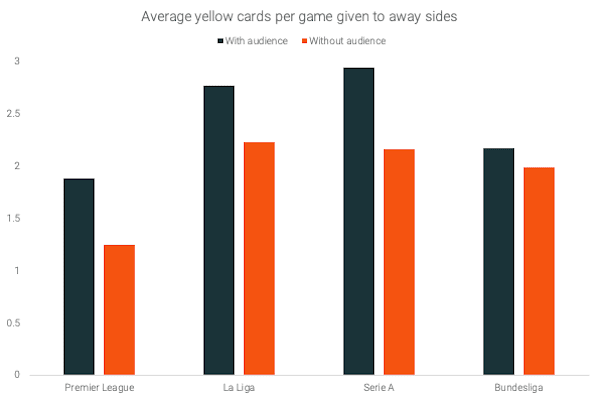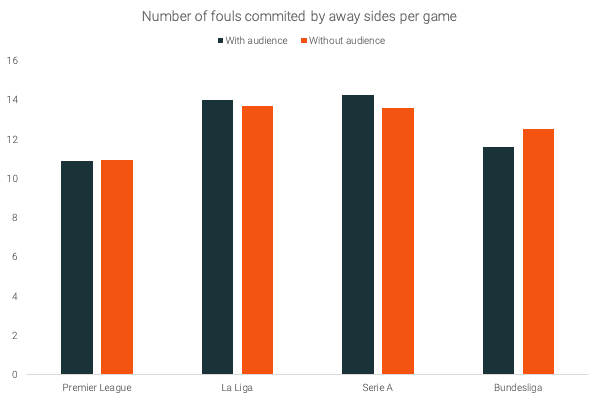By Tony Attwood
As you will know if you are a regular reader, Untold Arsenal conducts its own research into the way football is refereed, such as our famous 160 games series in which the first 160 games of a season were reviewed and the results presented complete with video evidence. The analysis, which is frankly shocking is still on line on this site.
Last season we started looking at how tackles relate to fouls and each relates to yellow cards, and through that research found utterly extraordinary figures for Leicester City. Then things got even stranger as after our review was published, the Leicester City approach to matches itself changed radically
Leicester’s strange tackle / foul / yellow cards figures change as they slip down the league
This season we are at it again with our review once more of tackles, fouls and yellows which show that now it is Wolverhampton who have the weirdest and most bizarre figures.
We have also drawn on two academic studies, one from Reading University and one from LSE. Our article on the media’s response to this includes links to the academic research.
But we are not alone in this as our good friends at RunRepeat are also undertaking research which takes in four leagues in Europe. What follows uses evidence from RunRepeat’s article:
Referees’ Home-Bias in Football Disappears without Crowds
We already know from the Reading University research that referees have been biased towards home teams. Now research which analysed referees’ performances in 1283 games from the top four European football leagues in 2019-20 has found that home-team advantage has disappeared from refereeing decisions since leagues restarted without crowds. Which suggests refs were being hopelessly biased in the Premier League when crowds were present.
The number of fouls per game has remained consistent to pre-COVID matches. And the number of yellow cards for home teams has also stayed consistent in the PL. But the average number of yellow cards per game awarded to away sides has decreased by 20.2% from 2.43 to 1.94.
If there is no crowd, refs give far fewer cards, but particularly so to away teams.
The second point about away teams is wholly consistent with the LSE research, which showed conclusively just how referees are influenced by home fans. The point we made when this research was first released was that PGMO who run Premier League refereeing were claiming before this an accuracy rate of over 98% for their refereeing decisions. This research shows that such a claim was wholly fictitious, a fact that must cast serious doubt on everything that PGMO has said about itself and its employees. This is apart from the fact that PGMO referees were making over three times as many errors as Swiss referees.
The new research from RunRepeat shows the variation in the handing out of yellow cards in various leagues comparing the figures with the crowd present and without

As they say,
“In three out of the four major leagues, the average number of yellow cards has decreased. The drop is the most obvious in the Premier League where the number of yellow cards has gone down from 3.5 cards/game to 2.53 cards/game (-28%).”
Only two explanations exist for this. One is that the players clean up their acts when there is no crowd present, the other is that referees are influenced by crowds into handing out more cards – except in Germany.
But the LSE figures show that home teams benefited from referee bias previously because the home crowd influences the referee.
In the Premier League however the home sides are now also getting fewer yellow cards.

But the away teams are getting even fewer yellow cards.

As the report says, “When we look at overall figures from all leagues, we see a 20.2% decrease in the number of yellow cards awarded to away sides.
“In the Premier League, the average has gone down from 1.88 cards/game to 1.24 cards/game. This is an incredible decrease of 34% in yellow cards dished out to away sides.” This is far, far higher than the other leagues. Indeed in the Bundesliga the drop was just 8.3% – under a quarter of the drop in the Premier League.
The inescapable fact is that referees in all leagues have in the past been influenced by the crowd, but that influence has been far, far, far higher in the PL than elsewhere. So much higher that the competence and ability of Premier League referees must now be called into account.
And now the killer punch. The number of fouls committed by away sides in the Premier League has not changed when we compare figures with a crowd, and without. But the number of yellow cards the away team gets has gone right down.
So the referees are still calling a foul a foul, but that personal decision as to when a foul becomes a yellow card offence, is what has changed. The home crowd howl, the PGMO referee gives the away player a yellow.

Across the leagues players have to commit more fouls to get a yellow when there is no crowd. But in England that change is much greater than elsewhere.
And for away teams, referees are allowing more fouls to away players before showing a yellow card – in the Premier League the figure has gone up by more than 50%.
As a result the home advantage which Premier League teams had due to referee bias when a crowd is present has now reversed. Now, with no crowd, the away team has the advantage.
In short these figures prove that home advantage was not down to familiarity with the pitch and environment, and not having to travel, it was totally due to referee bias because of the crowd. Now there is no crowd, that is removed.
As the report says, “away sides used to get more yellow cards in all leagues, and they also had an inferior fouls to cards ratio. However, without an audience, the disparity has disappeared, and in fact, the trend has reversed in some leagues.”
Referees are also giving fewer yellow cards and allowing more fouls before giving a yellow card. That is not the case in the Bundesliga where we have always noted that refereeing is quite different from that of PGMO.
The case for PGMO referees being the “best in Europe” was always dubious. Now we can see the reverse was always true.
We are really grateful to Run Repeat for allowing us such extensive use of their data. If you would like to communicate with Run Repeat please email vyom@runrepeat.com

In the current climate the crowd is not the catalyst for cards. It’s the radio in the ear that impacts the select official from PIGMOB.
Referees shd have a kpi key performance index to assess their performance. From what I know match fees for these guys have gone up.With it should come with accountability as in the corporate world.Too many are getting away with glaring errors.
Its about time the ref chief takes stronger action against error prone match officials.